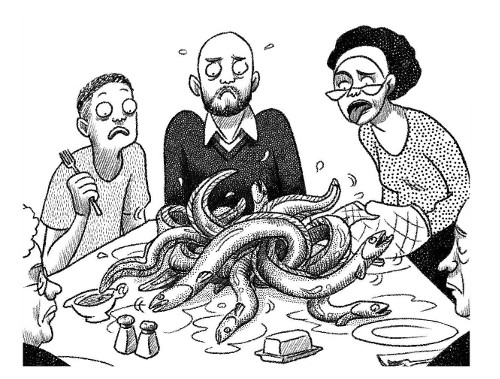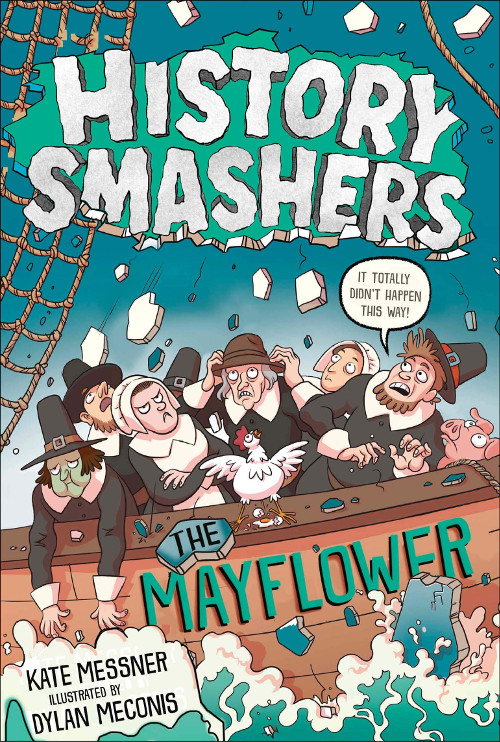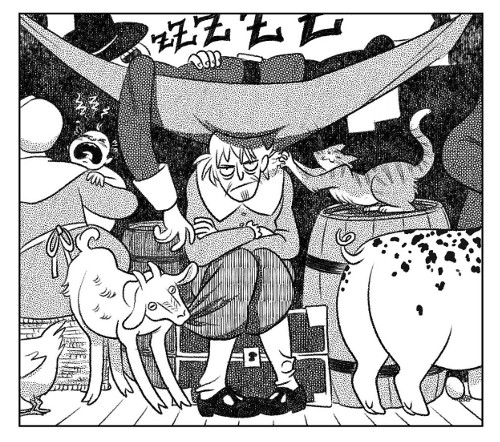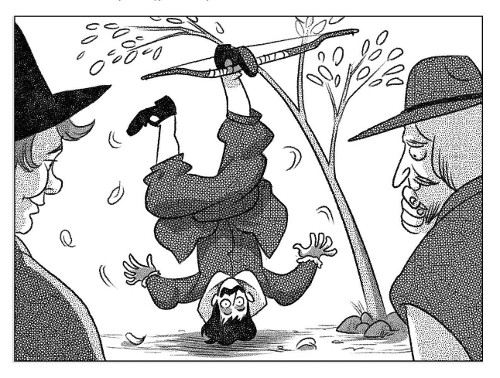Some History-Smashing Before Breakfast
 June 9th, 2020 by jules
June 9th, 2020 by jules

(Try telling your family you’d like to have eels for Thanksgiving dinner this year,
in honor of the Pilgrims, and let me know how that goes!)”
“It totally didn’t happen this way!” says a Mayflower Pilgrim on the cover of Kate Messner’s The Mayflower (Random House, July 2020), illustrated by Dylan Meconis.
If you had to summarize this book in one sentence, that would about cover it. This is the first in Messner’s new series, called History Smashers, though as I understand it, this book is publishing simultaneously with Women’s Right to Vote, another book in the same series. (I haven’t seen that one yet.) The Mayflower will be on shelves early next month, and I’ve got a galley of this refreshing book.
A nonfiction book aimed at young readers, it’s a book I wish were in every American History class in this country — in both elementary and middle-grade classrooms. Here’s how Messner introduces the book:
You’ve probably heard about the Mayflower. Chances are, someone told you about the Pilgrims, who came to America because they wanted religious freedom. You probably learned how they crossed the wild Atlantic, how they landed at Plymouth Rock in Massachusetts, how the Wampanoag people taught them to grow corn, and how they all celebrated by sitting down together for a feast — the very first Thanksgiving. But only parts of that story are true.
There’s a lot more to the history of the Mayflower, the Pilgrims, and the Wampanoag. Here’s the real deal. …
(This is where I remind you I have a galley and that some of the text may have changed between galley and publication.)

In the early chapters, Messner — writing in a conversational, chummy tone — kicks things off with a look at who the Pilgrims were, precisely why they wanted to leave England, and where they went before actually heading to America. She also delves into a discussion of the Mayflower (and explains what the lesser-known Speedwell was). She describes the Pilgrims’ journey across the sea and gives accurate, myth-busting descriptions of what happened after they arrived, including a detailed look at their relationship with the Wampanoag people already in the area: “The Pilgrims often wrote about their new home,” Messner writes, “as a wild, unsettled place. … But of course, the land that became Plymouth was not really empty or desolate. … The truth is, the Wampanoag people had lived there for more than twelve thousand years. They’d built homes there, raised their families, and farmed the land long before the Pilgrims ever showed up.” The penultimate chapter is all about the “myth of the first Thanksgiving.”
Sidebars are placed throughout the book and include discussions about sources (an accessible definition early in the book of what primary sources are — and how “sometimes people lie in primary sources, too, sharing what they want others to believe instead of telling the whole truth”); how Pilgrims really dressed; who the passengers were; others ships that set off for Plymouth; “Plymouth Rock” and the inaccurate stories that are attached to it; the Mayflower Compact; what the interior of Pilgrims’ homes looked like; and much more. Meconis’s entertaining illustrations include mini-comics that animate certain portions of the book (though the Advance Reader’s Copy I have has only some of the art).
This book accomplishes a great deal (and the series is certainly a promising one). It provides more details and more accuracy about the Pilgrims, their voyage, and the first “Thanksgiving” than a lot of elementary classrooms in this country provide to students. It eradicates harmful stereotypes about the Wampanoag people (also known as the People of the First Light) that were here when the Pilgrims landed — and are still here (even Messner’s closing author’s note talks about how the Plimoth Plantation has added the Wampanoag Homesite to their museum). And it asks children to think critically about the information they are presented, both in the pages of the book and outside of it.
Here’s a bit more art from the book. …

(Click to enlarge)


THE MAYFLOWER. Text copyright © 2020 by Kate Messner. Illustrations copyright
© 2020 by Dylan Meconis. Illustrations reproduced by permission of the publisher, Random House, New York.
